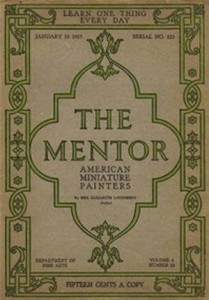THE work of John Trumbull as a historical painter has already been considered in The Mentor (No. 45), and in that number, too, the main facts of his life are told. John Trumbull was a patriotic American and a leader in the artistic and public life of his day, both in England and in America. His position was much more than that of a painter. His attitude toward painting was not one of complete and whole souled devotion. "I am fully sensible," he wrote at one time, "that the profession of painting as it is generally practised is frivolous, and unworthy a man who has talents for more serious pursuits. But to preserve and diffuse the memory of the noblest series of actions which have ever presented themselves in the history of man is sufficient warrant for it." We see accordingly that John Trumbull's idea of the work of a painter was to write history on canvas with a brush?and his pictures bear out his idea. His life governed and controlled his art. He was born in Lebanon, Connecticut, in 1756, a son of the Colonial governor of that State, and from early years he revealed a mental vigor that was extraordinary. He was an infant prodigy in learning. He entered Harvard College in the junior year at the age of fifteen, and the time he spent there was occupied in omniverous reading and study?which finally came near wrecking his health. When he was a student he visited the great painter John Singleton Copley, and became impressed with that great painter's idea of the dignity of an artist's life. He determined to study art, and he was learning to paint when the War of the Revolution began. This event determined the character of his art life. His skill in drawing being noted by General Washington, he was set to work making plans of the enemy's works. He was then promoted to a position on the general staff, and, afterward, served as colonel under Gates. But aggrieved at what he considered a tardy recognition of himself by Congress, he resigned from the army, went to England and there, meeting the distinguished artist, Benjamin West, took up under him the study of painting. When Major André was executed there was a spirit of retaliation aroused in England, and Trumbull was arrested and imprisoned as a spy. It was only the intercession of Benjamin West that saved his life. After seven months' imprisonment he was released, on condition that he leave the country. He did not leave, however, but continued his studies with West, and did not return to the United States until 1789. And so we see that Trumbull's life was more that of a patriot than a painter. Art was not the controlling factor with him, but the servant. He devoted his brush to the commemoration of great historical events, such as the battles of Bunker Hill and Trenton. And when he painted portraits he selected the prominent patriotic figures in the public life of his time?Washington, Alexander Hamilton, and others of like importance. It was only natural then that he should turn with an interest little short of enthusiasm to the portrait of that brave and gallant officer, Captain Lawrence. The face of Lawrence, as shown in Trumbull's miniature, is more rotund, more genial?not to say jovial?than we are led to believe it to be from other portraits. John Trumbull knew Lawrence, however, and found great satisfaction in this portrait. The special interest to us that distinguishes the portrait from others of Lawrence, is that it imparts a sense not so much of the military as of the personal character of the man. As pictured here, by Trumbull, he is a very human hero. In studying this portrait, we feel anew the gripping pathos of Lawrence's tragic end.
Mentor, january 15, 1917, serial no. 123
Sobre
Talvez você seja redirecionado para outro site












